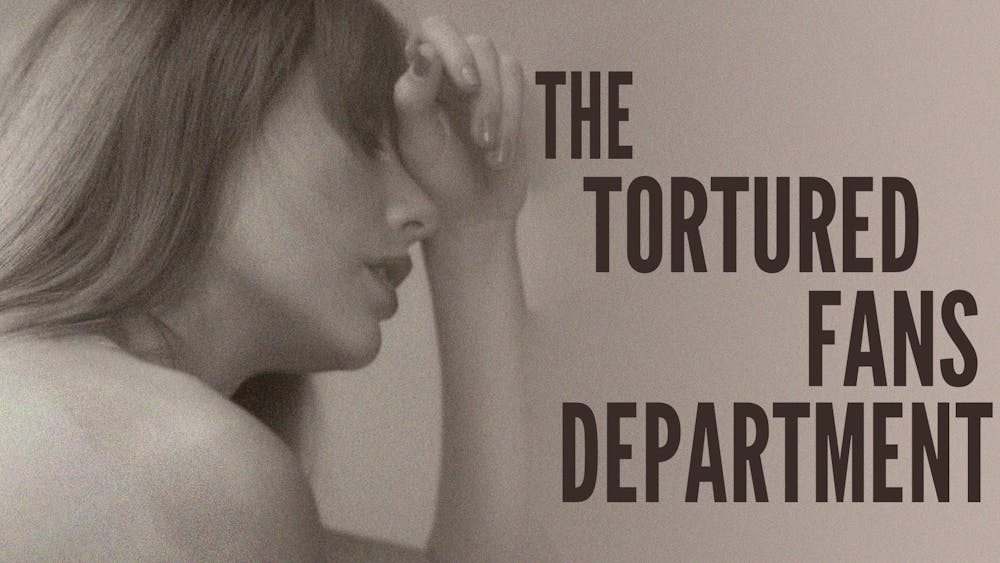History classes have research papers, business classes do group presentations, but film students make movies.
The 22nd Annual Notre Dame Student Film Festival features 15 short films created by students taking film production classes in the Department of Film,���Television and Theatre. Students — film majors and non majors alike — often take their spring or fall breaks to shoot footage.

Ted Mandell, a professor for the department and the festival's coordinator, says the film festival gives the student filmmakers a chance to see real-world reactions to their work.
"It's a reward for all the hard work that they do," he says. "Films are made to be shown in front of an audience, they're meant to be digested.
"It's a great sounding board for the students and a great ... lesson for how your work is exhibited and how the audience reacts to it."
Some of the student directors gave The Observer a quick overview of their projects.
The Elect

Directed by Dan Moore and Erin Zacek
Zacek: "The Elect" is a short, verite-style documentary that explores daily life inside the controversial Westboro Baptist Church. The film follows spokeswoman Shirley Phelps-Roper and her children as they carry out their day-to-day activities. Through a unique fly-on-the-wall perspective, the film allows the viewer to experience the oppressive reality of everyday existence within the church, while gaining a sense of how such hatred could be passed down from generation to generation.
Our idea came from curiosity from seeing them in the news: they are most famous for protesting at military funerals, and I was interested to see why in the world a group of people would do something so terrible; there had to be a reason behind their behavior.
Moore: I had first heard about the Westboro Baptist Church when they protested funerals of victims of the Northern Illinois University shooting back in 2008. I was furious and fascinated at the same time. What could create such senseless hatred? How could this spread from generation to generation? What is it really like inside the church? Especially, what would it be like to be a child in this church? It was in hopes of answering those questions that we traveled to Topeka to make the documentary.
Zacek: Shirley Phelps-Roper and the rest of her family were very hospitable towards us, which was so strange because it was completely opposite of their hateful ideology. They bought us dinner one night, and made sure we had water bottles for our drive home. That was definitely unexpected, as well as their willingness to let the camera into their daily life. We pretty much arrived at 7 a.m. and left at 7 p.m. and they let us film what we wanted.
Moore: The biggest challenge in making the film was surviving the shooting process. We spent two 10-hour days, one 12-hour day and one 4-hour day with members of the church. It was a mentally and emotionally draining experience to remain silent in the face of their relentless proclamation of their shocking ideology.
Offering
Directed by Duncan Smith
"Offering" examines the final moments of preparation for a priest and a soldier as they rise to face the culmination of their duty. The song that plays during the film, titled "My Comrade," inspired the piece.
In order to find a role for the film, I simply walked into Corby Hall asking to speak with any priest who was free at the moment and as it turned out, Fr. Simmons was perfect for the role!
Rosa Y Luna
Directed by Javi Zubizarreta, Michelle Carlisle Lee and Marie Wicht
Lee: "Rosa y Luna" is about the joys and challenges of single motherhood. The bond between a mother and her baby cannot be easily broken. Rosa is a young, single mother who is going back to work for the first time since giving birth to her baby Luna. Like many young women, she has to juggle work with motherhood on a limited income. Unlike most women, her job is as a full-time construction worker, and day care isn't an option.
Zubizarreta: The script was originally written for a screenwriting class taught by Jill Godmillow. The assignment was to write a script based on New Yorker cover art. My drawing was of a female construction worker breastfeeding atop a metal sky-rise. It was certainly intimidating writing for this subject and character — I obviously have no experience on the matter. So, I turned to my own mother, and talked to her about her experiences with motherhood and returning to work after having a child. She told me about the pain and hardship, and ultimately I channeled that into this film — taking many left turns along the way.
Lee: Our first challenge may have been our biggest. We had to find a newborn Hispanic baby, and a mother who felt comfortable breastfeeding on camera with her baby ... We ended up finding our actress by putting out an ad on the Mexican radio station in town, WSBL 98.1 FM, and then meeting with all the women who were interested at a local restaurant. We got very lucky — our actress did a great job.
Wicht: We used the home of our actress, Tania. She lived in a very small home within which we crammed the three of us, up to four extra crew members, the film equipment, lighting equipment and at times a crane rig for the camera all while simultaneously trying to film a space that made sure you couldn't see any of that. Most of the interior shots took place in a space approximately 20 feet by 30 feet with seven people, lighting rigs, a crane about a yard wide and 7 feet tall, not to mention the normal furniture and extra equipment.
Another huge challenge was working with Tania's daughter, a child of only one year, who we could never predict or direct. She was incredibly cooperative most of the time but we couldn't ask her to smile on command. It was a new experience trying to balance babysitting, directing, cinematography, loading film and everything else involved in making a film.
Zubizarretta: Absolutely everything was a challenge making this film — from casting to shooting to editing. For example, how do you make a button pop off a shirt on command? There's no information guide on that. And as a male director, how do you tell your actress that she, uh ... you know ... needs to look more ... more like ... she's breastfeeding? There were many awkward moments along the way and speed bumps aplenty. But ultimately, with Marie and Michelle working so hard, it came together wonderfully.
Picking Up America
Directed by Michael Burke and Marie Wicht
Wicht: The film is a documentary following the four young people of Pick Up America who are walking across the country picking up roadside trash in hopes of inspiring a nation-wide transition to a zero-waste America. The idea actually came from my partner Michael Burke who had the opportunity to meet the members of Pick Up America at a conference last year.
The biggest technical challenge of shooting "Picking Up America" was shooting a group of people who were constantly on the move. We never had time to set up a shot or really use a tripod, we had to constantly chase after the members of PUA while they worked. However, the biggest challenge in making the film otherwise was keeping focused on the shooting the film and not dropping the camera to help them in their cause. Pick Up America always needs volunteers and the amount of trash on the road was shocking. It was frustrating to be present and not be able to pick up trash with them. [They] picked up over a ton of trash in just the few days we filmed them.
Sacrifice Hits
Directed by Viviana Kim and Patrick Berry
Berry: "Sacrifice Hits" is a personal story of regret and redemption, and portrays baseball as a metaphor for life.
Kim: The idea sprung from an image that Pat had in his head: a 1950s setting in an alleyway with four or five young children playing ball together. That's really where it all started.
Berry: Viv and I picked a quote that we liked by a former Major League Baseball manager and went from there. The quote describes baseball as a metaphor for life, and we liked the idea of filming a baseball scene. After days of back-and-forth, Viv and I finally had a relatively coherent story to begin the project.
Kim: Shooting during a South Bend winter with lots of equipment, a small but wonderful crew, a dead battery in the light meter and several young children was definitely a challenge. I'd have to go with the untimely snow that came down the night before our first shoot that took place outdoors. But our kid actors are so adorable and great that I'm sure nobody will notice the continuity issues regarding South Bend's weather.
Berry: All of the sound in our project was recorded separately from the film and largely in different locations. This includes the sound effects, voiceovers and ambience noise. Also, we sent an e-mail to [University President Emeritus Fr. Theodore Hesburgh] to do a voice over of the quote, not expecting a response. To our delight, he graciously agreed to provide the voiceover that bookends our short.
Kim: The scene where young JP hits a baseball into the elderly woman's milk bottles were shot on two different days. JP and his friends were shot in a completely different location from the elderly woman's back porch location. The sound of that bottle breaking may have been the sound of a liquor bottle smashing on the sidewalk in front of my apartment.
Searching For Dillinger
Directed by Tom Demetrio and John Harig
Harig: The film is about a small town in Northwest Indiana called Monterey. The town is hidden away in the middle of nowhere and often gets people coming through that are hiding out from the law or other things. John Dillinger was rumored to have hidden out there, and some of the older townspeople have stories of Dillinger and other gangsters hiding out there. Our documentary is a humorous take on our attempts to uncover the mysteries surrounding Monterey and Dillinger's time there.
We originally planned on making a serious documentary about Monterey, but after several weeks of shooting, we realized that most of the townspeople were unwilling to go into great detail about what we wanted to know. After some suggestions from our professor, Tom and I decided to make the film into a parody of over-the-top investigative reports. Luckily, the people we did interview from Monterey were quite a cast of characters and gave us some great sound bites and shots.
The Zebra's Stripes
Directed by Duncan Smith and Rob Schaus
Smith: "The Zebra's Stripes" examines a traditional African folktale and the lessons it has to offer, set in a modern context. The story is viewed through a child's imagination, thus changing the traditional elements into a grade school setting of a 5-year-old girl. I read a story of the same title in an African anthology of poems and stories and wanted to translate it into a film.
You can't tell from watching it, but ... in actuality, the Zebra parents are the real-life parents of Bomani, the baboon villain.
Also playing:
True
Dylan McEnerney and Allen Murphy
A sleek noir thriller about a guy, a girl and the other guy.
Rick & Ilsa
Krissy Estrada and Dan Moore
The afternoon matinee of Bogart and Bergman brings together two dreamers in this homage to the classic film.
On/Off
Kurt Zhuang
A lonely television offers more than just the regular cable lineup.
The Art of the Chase
Pat Toland and Kelsie Kiley
A playful pickup line turns into a game of cat and mouse between a waitress and a patron.
Clutch
Michael Burke, Latifah Cato, Dylan McEnerney and Allen Murphy
Twists, turns and a tire squealing car chase.
Alice in Nightmareland
Andrew Cheng and Zachary Smith
Weird things happen when you fall asleep at 3 a.m. on the 10th floor of the library.
Five Months, Three Weeks
Paul Dechant and Clayton Smith
Dealing with pregnancy on her own, a mother-to-be learns to cope.
Pixel
Nick Andert and Jacob Griswold
A high tech firm sifts through the pixels to sort out doctored photos and videos and find the hacker responsible.
Synopses courtesy of the Department of Film, Television and Theatre
On Campus
What: Notre Dame Student Film Festival
Where: Browning Cinema, Debartolo Performing Arts Center
When: Jan. 20, 21 and 22, 6:30 p.m. to 9:30 p.m.
How much: $6, $5 faculty/staff, $3 students
Learn more: ftt.nd.edu












